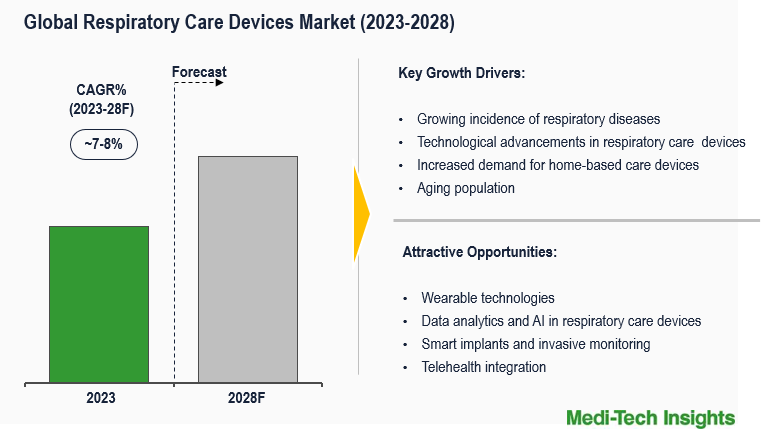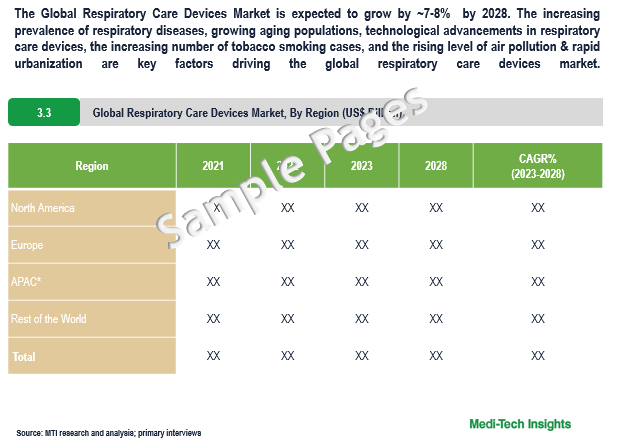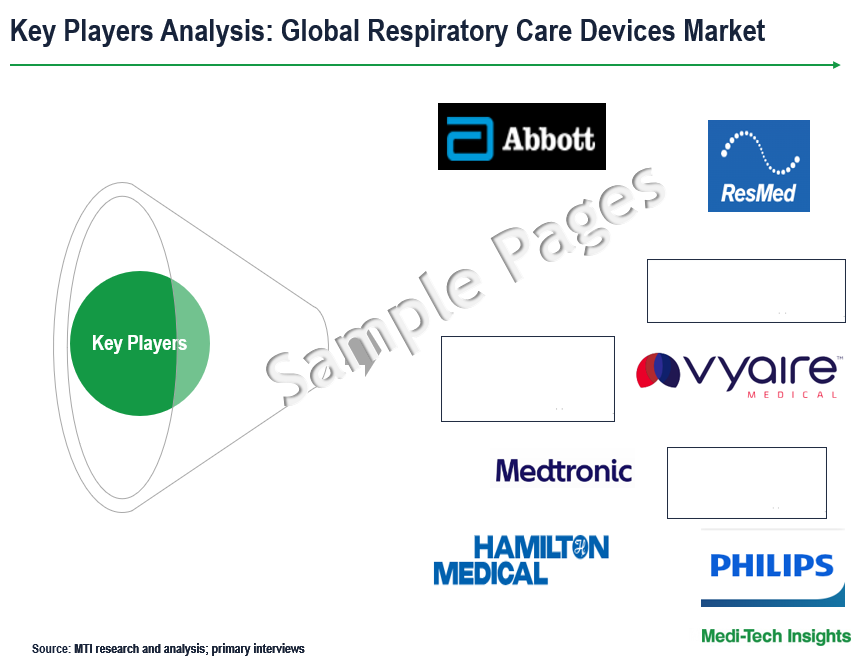
Respiratory Care Devices Market Size, Growth, Industry Trends, Share, Opportunity and Forecast to 2028
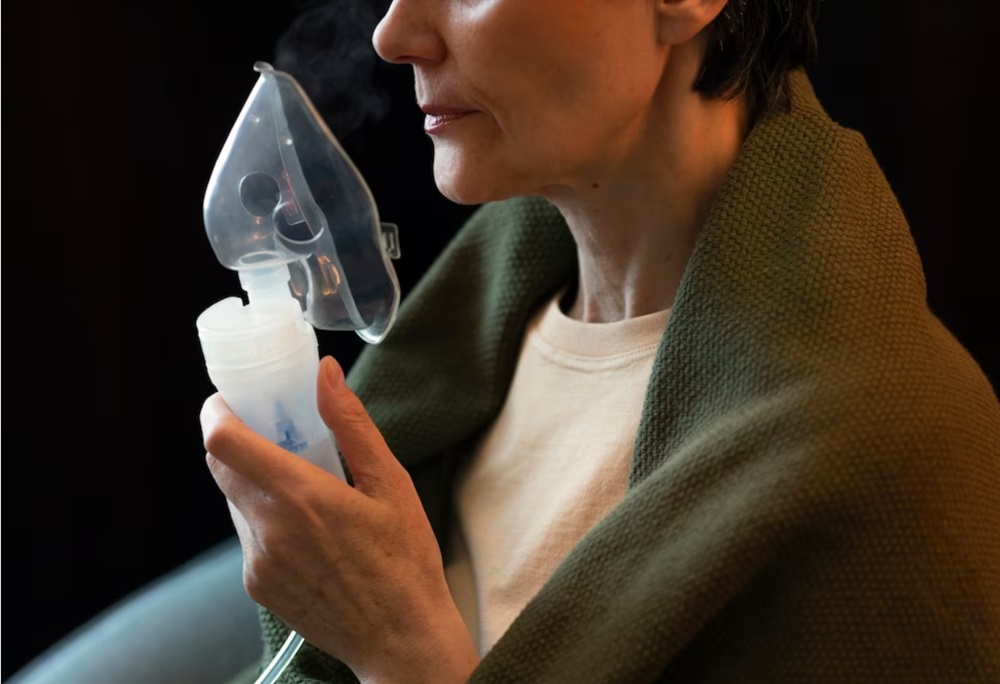
The Global Respiratory Care Devices Market is expected to grow by ~7-8% by 2028. The increasing prevalence of respiratory diseases, growing aging populations, technological advancements in respiratory care devices, increasing number of tobacco smoking cases, and the rising level of air pollution & rapid urbanization are key factors driving the global respiratory care devices market. To learn more about the research report, download a sample report.
Respiratory care devices are medical equipment used to diagnose, monitor, and treat respiratory conditions. They are crucial in managing various respiratory ailments, from asthma and COPD to sleep apnea and pneumonia.
Respiratory Care Devices are broadly classified into the following types:
- Diagnostic and Monitoring Devices: These devices help assess lung function and identify respiratory problems. Examples include spirometers, peak flow meters, and pulse oximeters
- Airway Devices: These devices maintain an open airway, ensuring adequate oxygen intake. Examples include laryngeal mask airways (LMAs) and endotracheal tubes
- Nebulizers: These devices convert liquid medications into a mist for easier inhalation, treating respiratory conditions like asthma and cystic fibrosis
- Positive Expiratory Pressure (PEP) Devices: These devices help clear mucus from the airways by creating back pressure during exhalation
- Ventilators: These devices provide mechanical breathing support for patients with severe respiratory failure
The Growing Prevalence of Chronic Obstructive Pulmonary Disease (COPD) Drives the Respiratory Care Devices Market
COPD is a chronic lung condition that causes damage to the air sacs in the lungs and long-term inflammation of the airways. According to the World Health Organization (WHO), COPD is the third deadliest disease in the world. Today, there are an estimated 480 million people who suffer from COPD. The study conducted by the Journal of the American Medical Association (JAMA) Network found that COPD prevalence among those 25 years and older is expected to increase by 23% from 2020 to 2050, with the largest growth projected among women and within low- and middle-income countries. Although COPD is progressive, it is treatable, and proper management and early intervention can provide symptom control, improved quality of life, and reduced risk of associated health problems. For instance,
- In August 2023, TidalSense announced the launch of the regulated AI technology for COPD, which uses the N-Tidal device. The technology combines N-Tidal’s CO2 sensor data, with an artificial intelligence platform that measures changes in lung function that might point towards a diagnosis of COPD. The medical tool can indicate a patient’s risk of COPD within minutes
To learn more about this report, download the PDF brochure
The Advent of Advanced Respiratory Care Technologies Fuels the Demand
Innovative respiratory solutions, powered by technology, empower individuals dealing with conditions like asthma, chronic obstructive pulmonary disease (COPD), or obstructive sleep apnea (OSA) by facilitating timely symptom monitoring and the implementation of preventive measures to avert emergencies. Leading the way in respiratory care technology are wearable IoT devices, intelligent inhalers, cloud-based respiratory therapies, and automated CPAP systems. The integration of these cutting-edge solutions into clinical practice has the potential to revolutionize the management of respiratory conditions. As a result, the ongoing advancements in respiratory care technologies hold the promise of making the future brighter for patients grappling with respiratory illnesses. Some of the recent advancements in respiratory care devices include:
- Smart Inhalers: Smart inhalers are inhaler devices equipped with sensors and connectivity features to monitor medication usage. The data collected by these smart inhalers can be used by clinicians and doctors to better understand the needs of each patient. These inhalers are used to treat COPD such as asthma by delivering bronchodilator medication straight to the airway, without it passing through the blood
- Advanced Algorithms: Digital health technologies can effectively aid the diagnosis and management of a wide range of chronic respiratory diseases. AI algorithms can analyze medical imaging, such as chest X-rays, to aid in the early diagnosis of respiratory conditions
- Wearable Devices: Advances in miniaturization and portability have led to the development of compact respiratory care devices that patients can easily carry and use on the go. Portable nebulizers, pocket-sized ventilators, and wearable respiratory monitors contribute to improved mobility and convenience
- Telehealth Solutions: Telehealth and remote patient monitoring have become integral in respiratory care. Digital platforms enable healthcare providers to remotely monitor patients with chronic respiratory conditions, optimizing care delivery and allowing for timely interventions
- Non-invasive Ventilation (NIV) Devices: Non-invasive ventilation devices, such as bilevel positive airway pressure (BiPAP) and continuous positive airway pressure (CPAP) machines, continue to see improvements in terms of design, comfort features, and data connectivity, making them more patient-friendly
Respiratory Care Devices Market: Covid-19 Impact
The emergence of severe acute respiratory syndrome (SARS) COVID-19 has marked a significant turning point for the respiratory solutions industry. The unprecedented demand for oxygen concentrators, spirometers, ventilators, positive airway pressure (PAP) devices, and nebulizers has propelled the industry's growth. Although this surge in demand had a temporary yet substantial impact on the market, it underscored the pivotal role played by respiratory care devices in the realm of healthcare.
The pandemic has also expedited the preference for home-based services as an alternative to hospitalization, leading to a sudden surge in the need for oxygen cylinders, pulse oximeters, mini ventilators, and continuous positive airway pressure (CPAP) units. Additionally, individuals with bronchitis or other respiratory disorders have taken extra precautions, considering bronchitis is classified under chronic obstructive pulmonary disease (COPD) and poses a significant risk of SARS-CoV-2 infection, further exacerbating the situation. The heightened vulnerability of patients with respiratory issues and other chronic conditions has consequently escalated the demand for breathing devices amid the epidemic.
North America Expected to Continue to Hold a Major Share in the Respiratory Care Devices Market
From a geographical perspective, North America holds a major market share of the respiratory care devices market. This can be mainly attributed to the growing prevalence of respiratory diseases, the higher adoption of new and advanced respiratory care devices, the sedentary lifestyle of the people, and the continued habit of smoking cigarettes in the region. However, the Asia-Pacific region is expected to witness strong growth in the coming years due to an aging population, the rising level of air pollution, and growing innovation in respiratory care devices in the region.
Respiratory Care Devices Market: Competitive Landscape
Some of the key players operating in the market include GE Healthcare, Philips Respironics (Philips Healthcare), Masimo Corporation, Hamilton Medical, Smiths Medical, TidalSense, Vyaire Medical, Devilbiss Healthcare Llc, Medtronic PLC, Drägerwerk AG & Co. KGaA, Fisher & Paykel Healthcare Limited, and ResMed Inc., among others.
Organic and Inorganic Growth Strategies
Players operating in this market are adopting organic and inorganic growth strategies such as launching new products, acquiring related firms, and entering collaborations to garner higher market share. For instance,
- In June 2023, Avanos Medical, Inc. announced that they had entered into a definitive agreement to sell its Respiratory Health (RH) business to SunMed Group Holdings, LLC (SunMed). This deal will give SunMed a strong foothold in the respiratory care market, as Avanos Medical is a leading provider of respiratory care products
- In March 2023, Vitalograph, a developer and producer of respiratory diagnostic devices launched its VitaloPFT Pulmonary Function Testing Series, aimed for use in secondary care
The Respiratory Devices Market is poised for growth in the upcoming years, driven by increasing approvals for respiratory devices, a transition in focus towards addressing more common respiratory diseases, and the adoption of robust organic and inorganic growth strategies by market players.
Key Strategic Questions Addressed
- What is the market size and forecast for the Respiratory Care Devices Market?
- What are the historical, present, and forecasted market shares and growth rates of various segments and sub-segments of the Respiratory Care Devices Market?
- What are the major growth drivers, restraints/challenges impacting the market?
- What are the opportunities prevailing in the market?
- What is the investment landscape?
- Which region has the highest share in the market? Which region is expected to witness the highest growth rate in the next 5 years?
- Who are the major players operating in the market? What is the competitive positioning of key players?
- Who are the new players entering the market?
- What are the key strategies adopted by players?
- Research Methodology
- Secondary Research
- Primary Research
- Market Estimation
- Market Forecasting
- Executive Summary
- Market Overview
- Market Dynamics
- Drivers
- Restraints
- Opportunities
- Industry Speaks
- Market Dynamics
- Global Respiratory Care Devices Market - Size & Forecast (2021-2028), By Product
- Therapeutic Respiratory Care Devices
- Respiratory Care Monitoring Devices
- Diagnostics Respiratory Care Devices
- Consumables and Accessories
- Global Respiratory Care Devices Market - Size & Forecast (2021-2028), By Disease Indication
- Chronic Obstructive Pulmonary Disease (COPD)
- Sleep Apnea
- Asthma
- Infectious Diseases
- Other Disease Indications
- Global Respiratory Care Devices Market - Size & Forecast (2021-2028), By End User
- Hospitals
- Home Care Settings
- Ambulatory Care Centers (ACCs)
- Other End Users
- Global Respiratory Care Devices Market - Size & Forecast (2021-2028), By Region
- North America (U.S. & Canada)
- Europe (UK, Germany, France, Italy, Spain, Rest of Europe)
- Asia Pacific (China, India, Japan, Rest of Asia Pacific)
- Rest of the World (Latin America, Middle East & Africa)
- Competitive Landscape
- Key Players and their Competitive Positioning
- Competitive Positioning of Key Players (2022)
- Offerings Assessment, By Players
- Key Strategies Assessment, By Player (2021-2023)
- New Product Launches
- Partnerships, Agreements, & Collaborations
- Mergers & Acquisitions
- Other Developments
- Key Players and their Competitive Positioning
- Key Companies Scanned (Indicative List)
- Hamilton Medical
- GE Healthcare
- Koninklijke Philips N.V.
- Devilbiss Healthcare Llc
- Medtronic PLC
- Drägerwerk AG & Co. KGaA
- Fisher & Paykel Healthcare Limited
- ResMed Inc.
- Masimo Corporation
- Smiths Medical
- Vyaire Medical
- TidalSense
- Other Prominent Players
The study has been compiled based on extensive primary and secondary research.
Secondary Research (Indicative List)
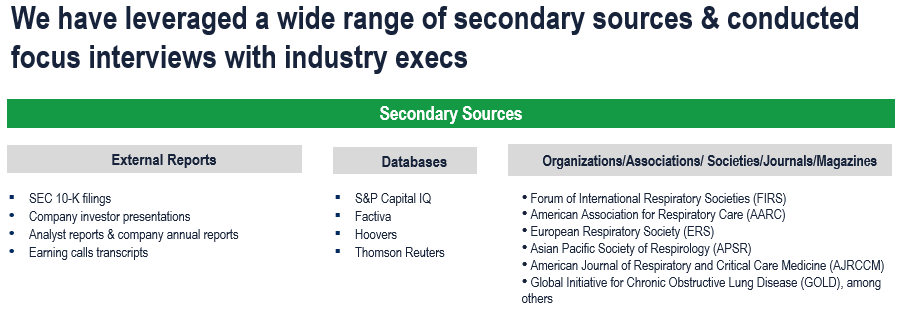
Primary Research
To validate research findings (market size & forecasts, market segmentation, market dynamics, competitive landscape, key industry trends, etc.), extensive primary interviews were conducted with both supply and demand-side stakeholders.
Supply Side Stakeholders:
- Senior Management Level: CEOs, Presidents, Vice-Presidents, Directors, Chief Technology Officers, Chief Commercial Officers
- Mid-Management Level: Product Managers, Sales Managers, Brand Managers, Business Development Managers, Consultants
Demand Side Stakeholders: Hospitals, Home Care Settings, and Ambulatory Care Centers, among others
Breakdown of Primary Interviews
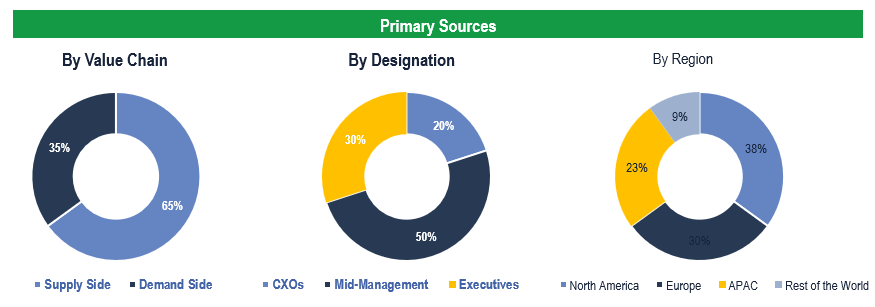
Market Size Estimation
Both ‘Top-Down and Bottom-Up Approaches’ were used to derive market size estimates and forecasts.
Data Triangulation
Research findings derived through secondary sources & and internal analysis were validated with Primary Interviews, Internal Knowledge Repository, and Company Sales Data.

